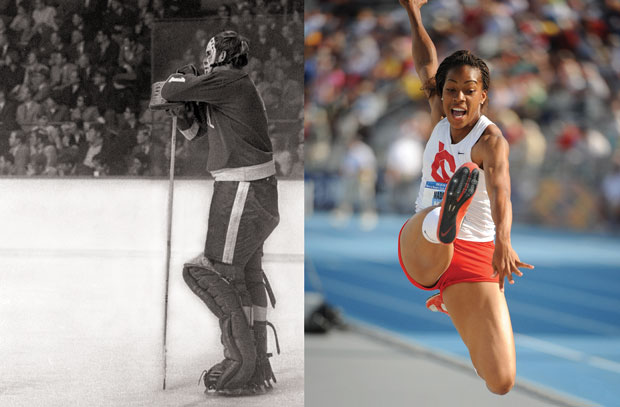
Ken Dryden ’69 (left), Jeomi Maduka ’09 (right). Photos by Athletic Communications.
Who are the greatest athletes ever to attend Cornell? Given the thousands of men and women who have competed on the Hill—in dozens of sports over several generations—is an answer even possible? In honor of the University’s Sesquicentennial celebration, we decided to try. CAM assembled a panel of experts and assigned them a mission: to determine the finest Cornellian athletes, however the judges may interpret that standard. All-around excellence? One-sport dominance? International impact? Greatness has many definitions.
The panel comprised twenty people who have observed Big Red sports over the past six decades, such as: Dick Loynd ’50, a member of the Cornell Athletic Hall of Fame; Jim Hanchett ’53, historian of the Cornell Football Association; Arthur Mintz ’71, the legendary announcer at Big Red football and hockey games; William “Buck” Briggs ’76, a football radio commentator; Heather Nichols ’80, BS HE ’82, director of admissions relations; and Howard Borkan ’81, a lacrosse radio analyst. It included chroniclers of the wider sports world: Mark Goldberg ’81, lifelong Ithacan and publisher of Athletic Management magazine; Steve Madden ’86, former CAM editor and general manager of sportsonearth.com; Brad Herzog ’90, author and longtime CAM contributing editor; Jeremy Schaap ’91, a reporter for ESPN; Liz Robbins ’92, a journalist at the New York Times and a member of the committee that oversees CAM; and Tom Fleischmann, veteran sports editor of the Ithaca Journal. We tapped past and present overseers of Cornell’s athletic communications: Dave Wohlhueter, Pat Gillespie, Jeremy Hartigan, and Julie Greco. The group was rounded out by leading Big Red sports officials: Andy Noel, director of athletics; Anita Brenner ’87, deputy director of athletics; Andrea Dutcher, MILR ’87, senior associate director of athletics for physical education; and Jim Case, associate head athletic trainer.
Assembling the panel was the easy part. Distilling 500-plus Cornell Athletic Hall of Famers into a manageable list of nominees? That was tough. We only considered undergraduate alumni, and only athletic achievements during and after college. Thus Olympic gold medal-winning swimmers like Pablo Morales, JD ’94, and Shelley Mann ’61 (who retired from competition before matriculating at Cornell) didn’t qualify. Still, we didn’t have room for several other gold medalists, longtime NFL players, All-Americans, Ivy Players of the Year, school record holders, and various athletes who were likely the most talented Cornellians in their particular sport, from swimming to sprint football.
In the end, we came up with fifty male and twenty-five female nominees—the difference in number reflecting the fact that, in general, athletic opportunities for men pre-date those for women by many decades. The panelists weighed in on those candidates, and the votes were tabulated to create lists of twenty male and ten female finalists—the best of the best. Finally, each judge was asked to rank those names in order of excellence.
How hard was it? Well, consider these remarkable athletes: Rhonda Anderson ’83 (basketball), Bruce Arena ’73 (multi-sport), John Bajusz ’87 (basketball), Liz Bishop ’07 (volleyball), Bill DeGraaf ’56 (multi-sport), Tim Goldstein ’88 (lacrosse), Derrick Harmon ’84 (football), Pam Hunt ’94 (cross-country), Alyson Intihar ’10 (softball), Katy Jay ’03 (track), Chad Levitt ’97 (football), Dan Mackesey ’77 (multi-sport), Dick Meade ’56 (multi-sport), Doug Murray ’03 (hockey), Erik Rico ’02 (baseball), Gary Wood ’64 (football), and Chris Zingo ’94 (football). All were legends on the Hill. None of them made the list of honorees.
Seven-time U.S. tennis champion Bill Larned 1894 fell just short, too, as did four-time polo All-American Melissa Riggs ’02. And four-time Olympic hammer thrower Al Hall ’56; three-time All-American soccer stars Laurie Collier ’88 and Jen Smith ’90; two-time NCAA champion wrestler Travis Lee ’05, ME ’06; two-time Ivy Tennis Player of the Year Olga Itskhoki Harvey ’96; and Boston Marathon winner Jon Anderson ’71.
Of course, any such ranking is inherently subjective. Our list is no more definitive than, say, The Western Canon of twenty-six major literary works put forth by Harold Bloom ’51. But this group of athletes does read like a pantheon.
The Men
1 KEN DRYDEN ’69
Ironically, the most enduring memory of hockey legend Ken Dryden is an image of inaction. When the puck was at the other end of the rink, the 6-foot-4 goalie would dig the tip of his blade into the ice, fold his arms across the top of his stick, and relax. It was his so-called “thinker’s pose,” and Dryden was the ultimate thinking man’s athlete. “He was contemplative,” noted the New York Times, “the product of a thoughtful mind coupled with the watchfulness of a skilled goaltender.”
This is, after all, a man who served as Ontario’s first Youth Commissioner, president of the National Hockey League’s Toronto Maple Leafs, and a member of the Canadian Parliament. A Hall of Famer who took a year off in the prime of his career to earn a law degree and later retired from the sport while still at the peak of his talents. The author of six acclaimed works of nonfiction—including The Game, widely considered the finest book ever written about hockey. “Playing goal is not fun,” Dryden wrote. “Behind a mask, there are no smiling faces, no timely sweaty grins of satisfaction. It is a grim, humorless position, largely uncreative, requiring little physical movement, giving little physical pleasure in return.”
A three-time All-American at Cornell, Dryden won 76 of his 81 varsity starts, including the 1967 NCAA championship. In 1971, he was called up to the Montreal Canadiens at the end of the season, ostensibly to serve as an apprentice goalie. Instead, he became the postseason starter and led the team to a Stanley Cup title. Dryden was named playoff MVP even though he wasn’t even yet eligible for Rookie of the Year honors; naturally, he won that award the following year. Dryden would go on to earn five Vezina Trophies as the goaltender allowing the fewest goals per game—along with five more Stanley Cups. He was named by The Hockey News as one of the 25 greatest players of all time, and his Number 29 Canadiens jersey was raised to the rafters in Montreal in 2007. His Cornell number was retired, too. Appropriately, it was 1.
2 ED MARINARO ’72
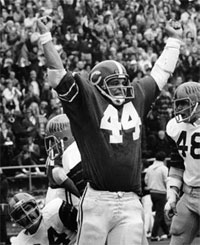 In the original version of the first-season finale of the groundbreaking Eighties cop drama “Hill Street Blues,” Officer Joe Coffey (played by Ed Marinaro) was fatally shot by a suspect at point blank range. But then the producers decided to re-edit the scene, and season two viewers were surprised to discover that Coffey had only been wounded. Marinaro wound up being a featured star of the show for five more years—until his character happened upon a robbery and was shot dead. Coffey was a tough guy to bring down.
In the original version of the first-season finale of the groundbreaking Eighties cop drama “Hill Street Blues,” Officer Joe Coffey (played by Ed Marinaro) was fatally shot by a suspect at point blank range. But then the producers decided to re-edit the scene, and season two viewers were surprised to discover that Coffey had only been wounded. Marinaro wound up being a featured star of the show for five more years—until his character happened upon a robbery and was shot dead. Coffey was a tough guy to bring down.
On the Schoellkopf gridiron, everyone knew that Number 44 was going to get the ball. Cornell’s offense was described as “Marinaro to the right, Marinaro to the left, Marinaro up the middle.” He gained a collegiate-record 4,715 yards in three varsity seasons, set or tied another 16 NCAA marks, scored 50 touchdowns, led the nation in rushing in 1970 and 1971, and capped off his career with a 230-yard, five-touchdown performance against Penn to clinch a share of the Ivy League title. Marinaro won every major college player of the year award except the Heisman Trophy. As in this ranking, he finished a close second.
3 CHARLES MOORE ’51
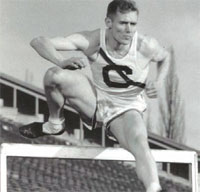 For mechanical engineering student and hurdler Charlie Moore, it was just a matter of math and motion. Moore figured that 13 strides between hurdles, rather than the customary 15, offered more power, more fluidity. The result: he never lost a race, winning four straight Amateur Athletic Union intermediate hurdles titles. And he was versatile, too, twice earning NCAA titles in the 440-yard dash and another in the 220-yard hurdles. His father had been an alternate as a hurdler on the U.S. Olympic track team. Nearly three decades later, Moore earned a gold medal in the 400-meter hurdles at the 1952 Summer Games, setting an Olympic record of 50.8 seconds on a rain-soaked track. He also won a silver medal with the U.S. 4×400-meter relay team. That year, he finished second in voting for the Sullivan Award, given to the nation’s top amateur athlete. In 1996, during a five-year stint as Cornell’s athletic director, Moore was selected in a process coordinated by the U.S. Olympic Committee as one of “100 Golden Olympians.”
For mechanical engineering student and hurdler Charlie Moore, it was just a matter of math and motion. Moore figured that 13 strides between hurdles, rather than the customary 15, offered more power, more fluidity. The result: he never lost a race, winning four straight Amateur Athletic Union intermediate hurdles titles. And he was versatile, too, twice earning NCAA titles in the 440-yard dash and another in the 220-yard hurdles. His father had been an alternate as a hurdler on the U.S. Olympic track team. Nearly three decades later, Moore earned a gold medal in the 400-meter hurdles at the 1952 Summer Games, setting an Olympic record of 50.8 seconds on a rain-soaked track. He also won a silver medal with the U.S. 4×400-meter relay team. That year, he finished second in voting for the Sullivan Award, given to the nation’s top amateur athlete. In 1996, during a five-year stint as Cornell’s athletic director, Moore was selected in a process coordinated by the U.S. Olympic Committee as one of “100 Golden Olympians.”
4 KYLE DAKE ’13
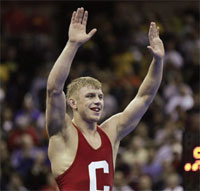 When Jodi Dake went into labor with her first child, her husband, Doug, was helping to coach a Big Red wrestling practice. At age 11, the boy watched the first-ever match at Friedman Wrestling Center. Always destined to be a Cornell grappler, Kyle Dake would graduate as arguably the most accomplished wrestler in NCAA history. Only three collegiate wrestlers have won four Division I national titles; only one, Dake, did it without skipping a season by taking a redshirt year. And only Dake did it in four different weight classes; no other wrestler has even done it in three. He won at 141 pounds as a freshman, 149 as a sophomore, and 157 as a junior. Finally, he defeated the defending champion and reigning NCAA Wrestler of the Year to win at 165 pounds in 2013. The first Cornellian in 53 years to be named Outstanding Wrestler of the NCAA Tournament, he also was voted Ivy, Eastern, and NCAA Wrestler of the Year and Sports Illustrated’s male College Athlete of the Year. Dake, who was undefeated over his last two seasons, has set his sights on becoming a 2016 Olympic gold medalist. Would you bet against him?
When Jodi Dake went into labor with her first child, her husband, Doug, was helping to coach a Big Red wrestling practice. At age 11, the boy watched the first-ever match at Friedman Wrestling Center. Always destined to be a Cornell grappler, Kyle Dake would graduate as arguably the most accomplished wrestler in NCAA history. Only three collegiate wrestlers have won four Division I national titles; only one, Dake, did it without skipping a season by taking a redshirt year. And only Dake did it in four different weight classes; no other wrestler has even done it in three. He won at 141 pounds as a freshman, 149 as a sophomore, and 157 as a junior. Finally, he defeated the defending champion and reigning NCAA Wrestler of the Year to win at 165 pounds in 2013. The first Cornellian in 53 years to be named Outstanding Wrestler of the NCAA Tournament, he also was voted Ivy, Eastern, and NCAA Wrestler of the Year and Sports Illustrated’s male College Athlete of the Year. Dake, who was undefeated over his last two seasons, has set his sights on becoming a 2016 Olympic gold medalist. Would you bet against him?
5 BO ROBERSON ’58
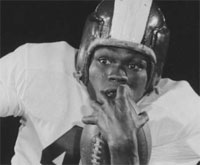 Dick Schaap ’55 chronicled sports for nearly half a century—and claimed he never saw a better natural athlete in Ivy League history than Irvin “Bo” Roberson. Basketball? Roberson played one varsity season as a 6-foot-1 center, averaging 14.9 points and 17.6 rebounds (second best in school history). He scored 37 against Penn. Track and field? He won five indoor and outdoor Heptagonal titles as a sprinter and long jumper, earned a gold medal in the long jump at the 1959 Pan-American Games, then broke Jesse Owens’s 25-year-old world indoor record by leaping 25 feet, 9½ inches at the National AAU Track and Field Championships. At the 1960 Summer Olympics, Roberson earned a silver medal in the event—one centimeter short of the gold. Football? He set the Cornell record for longest kickoff return (100 yards), led the team in rushing as a sophomoreand junior, and was a two-time All-Ivy selection. Roberson then played pro football for six seasons. He was team MVP of the 1962 Oakland Raiders and the top receiver on the 1965 American Football League-champion Buffalo Bills. As Schaap once put it, simply: “He was a beautiful athlete.”
Dick Schaap ’55 chronicled sports for nearly half a century—and claimed he never saw a better natural athlete in Ivy League history than Irvin “Bo” Roberson. Basketball? Roberson played one varsity season as a 6-foot-1 center, averaging 14.9 points and 17.6 rebounds (second best in school history). He scored 37 against Penn. Track and field? He won five indoor and outdoor Heptagonal titles as a sprinter and long jumper, earned a gold medal in the long jump at the 1959 Pan-American Games, then broke Jesse Owens’s 25-year-old world indoor record by leaping 25 feet, 9½ inches at the National AAU Track and Field Championships. At the 1960 Summer Olympics, Roberson earned a silver medal in the event—one centimeter short of the gold. Football? He set the Cornell record for longest kickoff return (100 yards), led the team in rushing as a sophomoreand junior, and was a two-time All-Ivy selection. Roberson then played pro football for six seasons. He was team MVP of the 1962 Oakland Raiders and the top receiver on the 1965 American Football League-champion Buffalo Bills. As Schaap once put it, simply: “He was a beautiful athlete.”
6 JOE NIEUWENDYK ’88
 “I was a shy, skinny kid when I went to Cornell in 1984,” Joe Nieuwendyk recalled in his Hockey Hall of Fame induction speech four years ago. “I remember calling my parents every night for about a month—to come and get me and bring me home. I didn’t think I was cut out for it.”Then this happened: he became a two-time All-America selection, scoring 73 goals in 81 games for the Big Red, and was a finalist for the 1987 Hobey Baker Award, given to college hockey’s top player. Nieuwendyk skipped his senior year to jump to the NHL, where he promptly earned Rookie of the Year honors and became only the second first-year player to surpass 50 goals in a season. Over 20 NHL seasons, he recorded 564 goals and 562 assists, made four all-star teams, was named playoff MVP, and won Stanley Cup titles with three different teams. He also owns an Olympic gold medal.
“I was a shy, skinny kid when I went to Cornell in 1984,” Joe Nieuwendyk recalled in his Hockey Hall of Fame induction speech four years ago. “I remember calling my parents every night for about a month—to come and get me and bring me home. I didn’t think I was cut out for it.”Then this happened: he became a two-time All-America selection, scoring 73 goals in 81 games for the Big Red, and was a finalist for the 1987 Hobey Baker Award, given to college hockey’s top player. Nieuwendyk skipped his senior year to jump to the NHL, where he promptly earned Rookie of the Year honors and became only the second first-year player to surpass 50 goals in a season. Over 20 NHL seasons, he recorded 564 goals and 562 assists, made four all-star teams, was named playoff MVP, and won Stanley Cup titles with three different teams. He also owns an Olympic gold medal.
7 EAMON McENEANEY ’77
 Eamon McEneaney was the kind of free spirit who first met his future wife at the Nines—while he was clad in nothing but a towel, following a streaking rally. He was the kind of lacrosse player who amassed eight points in the Big Red’s 1977 NCAA championship victory, after burning off energy that morning with a three-mile run. A three-time All-American, two-time Ivy Player of the Year, and one of only five Cornellians ever to be named Outstanding Player in Division I lacrosse, his three-year totals rank him third in school history with 256 points. McEneaney was the kind of athlete who doubled as a football star, earning All-Ivy accolades as a receiver. And he was the kind of guy who, following the 1993 World Trade Center bombing, helped 63 people to safety by orchestrating a human chain down 105 flights of stairs. A vice president at Cantor Fitzgerald, he perished in the September 11 attacks eight years later. The plaque honoring him at Schoellkopf Field reads: “Dedicated Husband and Father, Loyal Friend, Prolific Writer and Poet, and an American Hero.”
Eamon McEneaney was the kind of free spirit who first met his future wife at the Nines—while he was clad in nothing but a towel, following a streaking rally. He was the kind of lacrosse player who amassed eight points in the Big Red’s 1977 NCAA championship victory, after burning off energy that morning with a three-mile run. A three-time All-American, two-time Ivy Player of the Year, and one of only five Cornellians ever to be named Outstanding Player in Division I lacrosse, his three-year totals rank him third in school history with 256 points. McEneaney was the kind of athlete who doubled as a football star, earning All-Ivy accolades as a receiver. And he was the kind of guy who, following the 1993 World Trade Center bombing, helped 63 people to safety by orchestrating a human chain down 105 flights of stairs. A vice president at Cantor Fitzgerald, he perished in the September 11 attacks eight years later. The plaque honoring him at Schoellkopf Field reads: “Dedicated Husband and Father, Loyal Friend, Prolific Writer and Poet, and an American Hero.”
8 ROB PANNELL ’12
 In the storied history of Cornell lacrosse, only one Big Red player has twice been named the NCAA’s Outstanding Player. Rob Pannell received the honor in 2011 and in 2013. In the latter season (Pannell’s fifth year of eligibility after he was injured in 2012), the attackman scored 102 points while leading Cornell to the NCAA semifinals. In the history of Ivy League lacrosse, only one man has been named Ivy Player of the Year three times: Pannell, who was also a four-time All-American. And in the entire history of Division I collegiate lacrosse, nobody has scored more career points than Pannell did—354 of them on 150 goals and 204 assists. Naturally, after being selected by Major League Lacrosse’s New York Lizards with the Number 1 draft pick, Pannell became an all-star and the league’s Rookie of the Year.
In the storied history of Cornell lacrosse, only one Big Red player has twice been named the NCAA’s Outstanding Player. Rob Pannell received the honor in 2011 and in 2013. In the latter season (Pannell’s fifth year of eligibility after he was injured in 2012), the attackman scored 102 points while leading Cornell to the NCAA semifinals. In the history of Ivy League lacrosse, only one man has been named Ivy Player of the Year three times: Pannell, who was also a four-time All-American. And in the entire history of Division I collegiate lacrosse, nobody has scored more career points than Pannell did—354 of them on 150 goals and 204 assists. Naturally, after being selected by Major League Lacrosse’s New York Lizards with the Number 1 draft pick, Pannell became an all-star and the league’s Rookie of the Year.
9 GEORGE PFANN ’24
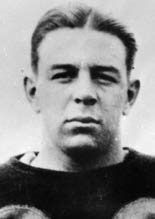 A few years ago, legendary sportswriter Dan Jenkins decided to choose Retro Heisman winners—players who would have won college football’s most coveted trophy had it existed in their era. He turned his gaze to 1923 and found George Pfann, a College Football Hall of Famer who never lost a varsity game. Pfann also played basketball and lacrosse, but was most renowned as an All-American quarterback-kicker-defender on the Cornell teams that produced three straight undefeated seasons from 1921–23 and an average winning margin of 44 to 3. He went on to become a Rhodes Scholar at Oxford (where he starred as a rugby player), a decorated member of General George Patton’s staff during World War II, and a professor of law on the Hill. Jenkins’s choice forrunner-up in 1923? Illinois star Red Grange, who years later was named by ESPN as the greatest college football player of all time.
A few years ago, legendary sportswriter Dan Jenkins decided to choose Retro Heisman winners—players who would have won college football’s most coveted trophy had it existed in their era. He turned his gaze to 1923 and found George Pfann, a College Football Hall of Famer who never lost a varsity game. Pfann also played basketball and lacrosse, but was most renowned as an All-American quarterback-kicker-defender on the Cornell teams that produced three straight undefeated seasons from 1921–23 and an average winning margin of 44 to 3. He went on to become a Rhodes Scholar at Oxford (where he starred as a rugby player), a decorated member of General George Patton’s staff during World War II, and a professor of law on the Hill. Jenkins’s choice forrunner-up in 1923? Illinois star Red Grange, who years later was named by ESPN as the greatest college football player of all time.
10 JEROME “BRUD” HOLLAND ’39, MS ’41
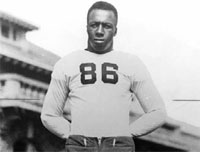 The father of football star Joe Holland ’78, MA ’78, Brud Holland was a pioneer. The first African American to play football at Cornell, he was twice named first team All-American, a remarkable feat considering that many Southern newspapers wouldn’t even run his photo. Then Holland graduated and really started achieving. He earned a master’s degree from Cornell and a doctorate from Penn and was inducted into the College Football Hall of Fame. He served as president of two universities and U.S. ambassador to Sweden and was the first African American to sit on the board of theNew York Stock Exchange. In 1972, the NCAA gave him its highest honor: the Theodore Roosevelt Award, presented to “a distinguished citizen of national reputation and outstanding accomplishment.” In 1985, four months after Holland passed away, Ronald Reagan awarded him the Presidential Medal of Freedom, lauding him as “an inspiration to millions.”
The father of football star Joe Holland ’78, MA ’78, Brud Holland was a pioneer. The first African American to play football at Cornell, he was twice named first team All-American, a remarkable feat considering that many Southern newspapers wouldn’t even run his photo. Then Holland graduated and really started achieving. He earned a master’s degree from Cornell and a doctorate from Penn and was inducted into the College Football Hall of Fame. He served as president of two universities and U.S. ambassador to Sweden and was the first African American to sit on the board of theNew York Stock Exchange. In 1972, the NCAA gave him its highest honor: the Theodore Roosevelt Award, presented to “a distinguished citizen of national reputation and outstanding accomplishment.” In 1985, four months after Holland passed away, Ronald Reagan awarded him the Presidential Medal of Freedom, lauding him as “an inspiration to millions.”
The Runners-Up
11 MEREDITH GOURDINE ’52
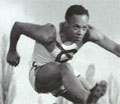 After a versatile Big Red career in which he was an All-American in both the long jump and 400-meter hurdles, “Flash” Gourdine took the long jump silver medal at the 1952 Summer Olympics.
After a versatile Big Red career in which he was an All-American in both the long jump and 400-meter hurdles, “Flash” Gourdine took the long jump silver medal at the 1952 Summer Olympics.
 12 MIKE FRENCH ’76
12 MIKE FRENCH ’76
A three-time All-American who led the Big Red to the 1976 national lacrosse title, French avraged more than four goals per game at Cornell, second best in college lax history. He is the only member of both the Canadian and U.S. lacrosse halls of fame.
13 DICK SAVITT ’50
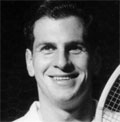 After winning 57 of 59 collegiate tennis matches, in 1951 Savitt won both Wimbledon and the Australian singles championship. The only other Americans to subsequently match that major championship double? Jimmy Connors and Pete Sampras.
After winning 57 of 59 collegiate tennis matches, in 1951 Savitt won both Wimbledon and the Australian singles championship. The only other Americans to subsequently match that major championship double? Jimmy Connors and Pete Sampras.
14 MAX SEIBALD ’09
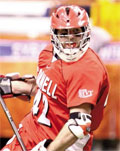 A four-time All-American, he was named the Outstanding Player in Division I lacrosse in 2009. The following year, the midfielder played on the winning U.S. national team at the 2010 World Lacrosse Championships.
A four-time All-American, he was named the Outstanding Player in Division I lacrosse in 2009. The following year, the midfielder played on the winning U.S. national team at the 2010 World Lacrosse Championships.
15 HILLARY CHOLLET ’49, MD ’54
 He was the outstanding allaround player on the Big Red basketball team, scoring a then-school-record 37 points against Syracuse. And he was a standout running back and safety in football, a Chicago Tribune first-team All-American.
He was the outstanding allaround player on the Big Red basketball team, scoring a then-school-record 37 points against Syracuse. And he was a standout running back and safety in football, a Chicago Tribune first-team All-American.
16 DAVE AUBLE ’60, MBA ’62
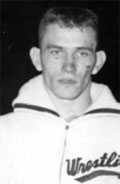 A 2010 inductee into the National Wrestling Hall of Fame and twotime NCAA champion at 123 pounds, his combined record in collegiate and Amateur Athletic Union competition was 75-2. He finished fourth in his weight class at the 1964 Olympics.
A 2010 inductee into the National Wrestling Hall of Fame and twotime NCAA champion at 123 pounds, his combined record in collegiate and Amateur Athletic Union competition was 75-2. He finished fourth in his weight class at the 1964 Olympics.
17 LANCE NETHERY ’79
 A threetime Cornell hockey MVP and two-time All-American, he remains Number 1 in the Big Red record books for most single-season assists (60) and points (83) and most career assists (180) and points (271).
A threetime Cornell hockey MVP and two-time All-American, he remains Number 1 in the Big Red record books for most single-season assists (60) and points (83) and most career assists (180) and points (271).
18 PETE GOGOLAK ’64
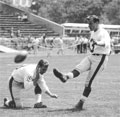 The first soccer-style place-kicker in college football history, he set a national record of 44 consecutive extra-point conversions. Gogolak then embarked on an 11-year pro football career and remains the New York Giants’ all-time leading scorer.
The first soccer-style place-kicker in college football history, he set a national record of 44 consecutive extra-point conversions. Gogolak then embarked on an 11-year pro football career and remains the New York Giants’ all-time leading scorer.
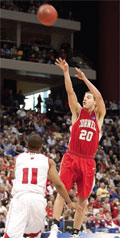 19 RYAN WITTMAN ’10
19 RYAN WITTMAN ’10
The 2010 Ivy League Player of the Year led Big Red basketball to the Sweet Sixteen and set various school records, including career marks for games started, minutes played, points, field goals, and three-pointers.
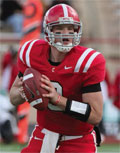 20 JEFF MATHEWS ’14
20 JEFF MATHEWS ’14
The most prolific quarterback in Ivy history, Mathews totaled 11,284 passing yards and 72 touchdown passes. He set 18 league marks for passing and total offense and holds 47 school records.
The Women
1 JEOMI MADUKA ’09
As athletic feats go, it is unprecedented. Jeomi Maduka may rank as Cornell’s best ever in two different sports played in the same season. Following the 2007–08 basketball season, the 6-foot-2 Maduka was named Ivy Player of the Year and honorable mention All-American, the only Big Red women’s player ever to achieve each honor. She finished in the league’s top three in scoring, steals, rebounds, and field goal percentage, surpassing 1,000 points in three seasons. Why only three? Because as a senior she opted to focus on track and field. Maduka was a seven-time All-American and is the school’s only multiple Heptagonals Most Outstanding Performer both indoor (three times) and outdoor (twice). In 2009, she became the first person ever to win four events (60 meters, 200 meters, long jump, triple jump) at a single Heps championship. Twice, as a long jumper in 2008 and 2012, she narrowly missed out on a spot on the U.S. Olympic team. How impressive was Maduka’s dual athletic life? As an undergrad, she occasionally competed in both sports on the same day.
2 REBECCA JOHNSTON ’11
 When hockey forward Rebecca Johnston arrived in Ithaca in 2007, the Big Red women’s team had won only 27 games over the previous five seasons and its fans numbered in the dozens. By the time she graduated, thousands of fans were celebrating Cornell’s three straight appearances in the Frozen Four. She was Ivy Rookie of the Year as a freshman, ECAC Player of the Year as a senior, a three-time All-American, and a three-time nominee for college player of the year. In the sport’s NCAA era (since 2000–01), Johnston ranks first in school history in points (188) and goals (97). In 2010, having taken a year off to compete for Canada’s national team, Johnston won gold at the Winter Olympics. Eight months later, her overtime goal against the U.S. led Canada to victory at the Four Nations Cup. After graduating, she joined the Canadian Women’s Hockey League, leading the Toronto Furies in scoring. In 2014, she led Team Canada in scoring while winning a second Winter Games title. Among all the athletes who have competed for Cornell over the years, she is the only one with two Olympic gold medals.
When hockey forward Rebecca Johnston arrived in Ithaca in 2007, the Big Red women’s team had won only 27 games over the previous five seasons and its fans numbered in the dozens. By the time she graduated, thousands of fans were celebrating Cornell’s three straight appearances in the Frozen Four. She was Ivy Rookie of the Year as a freshman, ECAC Player of the Year as a senior, a three-time All-American, and a three-time nominee for college player of the year. In the sport’s NCAA era (since 2000–01), Johnston ranks first in school history in points (188) and goals (97). In 2010, having taken a year off to compete for Canada’s national team, Johnston won gold at the Winter Olympics. Eight months later, her overtime goal against the U.S. led Canada to victory at the Four Nations Cup. After graduating, she joined the Canadian Women’s Hockey League, leading the Toronto Furies in scoring. In 2014, she led Team Canada in scoring while winning a second Winter Games title. Among all the athletes who have competed for Cornell over the years, she is the only one with two Olympic gold medals.
3 JAIMEE REYNOLDS WILSON ’02
 If Jaimee Reynolds Wilson only starred in lacrosse on the Hill, she would still rank among the school’s all-time great athletes. Just the third four-time All-American in any sport at Cornell, Wilson graduated with 11 school records, including season and career points, goals scored, and ground balls. A midfielder who excelled both offensively and defensively, she earned a spot on the All-America third team in each of her first three seasons before capturing first-team accolades as a senior, when she was one of three finalists for national player of the year. As a senior, she was named Ivy Player of the Year and scored seven goals to help Cornell upset seven-time defending champion Maryland and reach the NCAA semifinals. But she also played volleyball, lettering four times. In 2001, she recorded the sixth-most assists in school history. And the biological and mechanical engineering major graduated magna cum laude. In 2002, she became only the sixth Ivy Leaguer to be named a finalist for NCAA Woman of the Year.
If Jaimee Reynolds Wilson only starred in lacrosse on the Hill, she would still rank among the school’s all-time great athletes. Just the third four-time All-American in any sport at Cornell, Wilson graduated with 11 school records, including season and career points, goals scored, and ground balls. A midfielder who excelled both offensively and defensively, she earned a spot on the All-America third team in each of her first three seasons before capturing first-team accolades as a senior, when she was one of three finalists for national player of the year. As a senior, she was named Ivy Player of the Year and scored seven goals to help Cornell upset seven-time defending champion Maryland and reach the NCAA semifinals. But she also played volleyball, lettering four times. In 2001, she recorded the sixth-most assists in school history. And the biological and mechanical engineering major graduated magna cum laude. In 2002, she became only the sixth Ivy Leaguer to be named a finalist for NCAA Woman of the Year.
4 CARI HILLS ’98
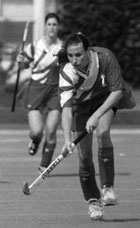 Which was Cari Hills’s best sport? It must have been field hockey, right? Hills was Ivy Rookie of the Year, Cornell’s first-ever All-American in the sport, and a three-time team MVP who still holds the school record for assists in a season and career. Or was it lacrosse? Hills was a two-time third-team All-American who set single-season school records for points and goals—and who once scored a goal in 31 consecutive games. Bottom line: she graduated at the top of the Big Red scoring list in both sports.
Which was Cari Hills’s best sport? It must have been field hockey, right? Hills was Ivy Rookie of the Year, Cornell’s first-ever All-American in the sport, and a three-time team MVP who still holds the school record for assists in a season and career. Or was it lacrosse? Hills was a two-time third-team All-American who set single-season school records for points and goals—and who once scored a goal in 31 consecutive games. Bottom line: she graduated at the top of the Big Red scoring list in both sports.
5 STEPHANIE BEST ’91
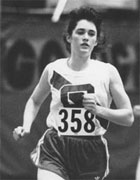 Distance runner Stephanie Best came darned close to living up to her name. In 1999, she placed second in the 1,500-meter run at the USA Outdoors and third at the Pan-American Games. This peak performance came a full eight years after the 10-time Heptagonals champion finished second in the NCAA indoor mile and third in the NCAA outdoor 1500. A generation later, she still holds school records for the fastest indoor and outdoor 1500-meter times at the Heps, cementing her place as one of the best.
Distance runner Stephanie Best came darned close to living up to her name. In 1999, she placed second in the 1,500-meter run at the USA Outdoors and third at the Pan-American Games. This peak performance came a full eight years after the 10-time Heptagonals champion finished second in the NCAA indoor mile and third in the NCAA outdoor 1500. A generation later, she still holds school records for the fastest indoor and outdoor 1500-meter times at the Heps, cementing her place as one of the best.
6 MORGAN UCENY ’07
 In three of the biggest races of her life, Morgan Uceny was a favorite who fell. Literally, she stumbled on the track at the 2011 world 1500-meter championships, at the 2012 Summer Olympics, and again at the 2014 U.S. championship. But Uceny’s career isn’t about falling down; it is about racing to the top. A four-time All-American in the indoor and outdoor 800 meters, she emerged after graduation as a world-class 1500-meter runner. She was the 2010 USA Indoor champion, the 2011 USA Outdoor champion, and winner of the 2012 U.S. Olympic trials. In the process, she ran to a spot reached by no other Cornellian middle distance runner—Number 1 in the world.
In three of the biggest races of her life, Morgan Uceny was a favorite who fell. Literally, she stumbled on the track at the 2011 world 1500-meter championships, at the 2012 Summer Olympics, and again at the 2014 U.S. championship. But Uceny’s career isn’t about falling down; it is about racing to the top. A four-time All-American in the indoor and outdoor 800 meters, she emerged after graduation as a world-class 1500-meter runner. She was the 2010 USA Indoor champion, the 2011 USA Outdoor champion, and winner of the 2012 U.S. Olympic trials. In the process, she ran to a spot reached by no other Cornellian middle distance runner—Number 1 in the world.
7 LAURA FORTINO ’13
 Cornell’s only three-time first team All-American women’s hockey player (and the top pick of the recent Canadian Women’s Hockey League draft), Laura Fortino scored 133 points in 133 collegiate games (98 of them on assists). But the defenseman’s most famous assist came eight minutes into overtime of the championship game of the 2014 Winter Olympics. That’s when Fortino, playing for Canada, faked a shot and sent a beautiful pass to a teammate. Moments later, her countrymen were celebrating what would henceforth be known as the Golden Goal.
Cornell’s only three-time first team All-American women’s hockey player (and the top pick of the recent Canadian Women’s Hockey League draft), Laura Fortino scored 133 points in 133 collegiate games (98 of them on assists). But the defenseman’s most famous assist came eight minutes into overtime of the championship game of the 2014 Winter Olympics. That’s when Fortino, playing for Canada, faked a shot and sent a beautiful pass to a teammate. Moments later, her countrymen were celebrating what would henceforth be known as the Golden Goal.
8 STEPHANIE MAXWELL-PIERSON ’86
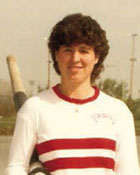 What do you do for an encore after collecting four silver medals in rowing during world championship competition? After competing in two Olympic Games, bringing home a bronze medal in coxed pairs in 1992? After winning more than two dozen national and international titles during an 11-year competitive career? After twice earning U.S. Rowing’s Female Athlete of the Year honors and eventual induction into the U.S. Rowing Hall of Fame? If you’re Stephanie Maxwell-Pierson, you switch to a bigger boat. In 1995, she was a member of the first all-female crew in America’s Cup yacht racing history.
What do you do for an encore after collecting four silver medals in rowing during world championship competition? After competing in two Olympic Games, bringing home a bronze medal in coxed pairs in 1992? After winning more than two dozen national and international titles during an 11-year competitive career? After twice earning U.S. Rowing’s Female Athlete of the Year honors and eventual induction into the U.S. Rowing Hall of Fame? If you’re Stephanie Maxwell-Pierson, you switch to a bigger boat. In 1995, she was a member of the first all-female crew in America’s Cup yacht racing history.
9 LAUREN MAY ’05
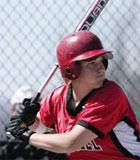 Lauren May was a two-time Ivy League Player of the Year and the first Cornell softball player to earn All-America status. The shortstop holds several Big Red career records, including batting average (.415), home runs (58), and runs batted in (190). So what did May accomplish during the doubleheader on the last day of her collegiate career? In the opener, she hit a game-winning grand slam. In the second game, she went 4-for-4, giving her the highest batting average (a stunning .496) in the nation.
Lauren May was a two-time Ivy League Player of the Year and the first Cornell softball player to earn All-America status. The shortstop holds several Big Red career records, including batting average (.415), home runs (58), and runs batted in (190). So what did May accomplish during the doubleheader on the last day of her collegiate career? In the opener, she hit a game-winning grand slam. In the second game, she went 4-for-4, giving her the highest batting average (a stunning .496) in the nation.
 10 GRACE ACEL HILLYER ANDERSON ’44
10 GRACE ACEL HILLYER ANDERSON ’44
A renowned athlete long before Title IX brought equal opportunity to the Hill, Anderson won the National Intercollegiate Women’s Fencing Association Championship in foil three times (once while attending William & Mary in 1941 and twice for Cornell, in 1942 and 1943), a feat no collegiate women’s fencer matched until 2002. After graduation, Anderson was a nationally ranked fencer until her retirement in 1956, representing the U.S. on three Olympic teams.


